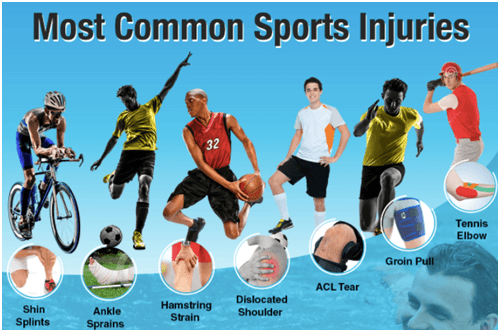Back to: PHYSICAL HEALTH EDUCATION JSS 2
Welcome to Class !!
We are eager to have you join us !!
In today’s Physical Health Education class, We will be discussing Preventing Injuries and Accidents. We hope you enjoy the class!
Measures for Preventing Sports Injury

The best way to prevent a sports injury is to warm up properly and stretch. Cold muscles are prone to overstretching and tears. Warm muscles are more flexible. They can absorb quick movements, bends, and jerks, making injury less likely.
Also, take these steps to avoid sports injuries:
- Use the proper technique:
Learn the proper way to move during your sport or activity. Different types of exercise require different stances and postures. For example, in some sports, bending your knees at the right time can help avoid an injury to your spine or hips.
- Have the proper equipment:
Wear the right shoes. Make sure you have the proper athletic protection. Ill-fitting shoes or gear can increase your risk of injury.
- Don’t overdo it:
If you do get hurt, make sure you’re healed before you start the activity again. Don’t try to “work through” the pain.
When you return after letting your body recover, you may need to ease yourself back into the exercise or sport rather than jumping back in at the same intensity.
- Cooldown:
Remember to cool down after your activity. Usually, this involves doing the same stretching and exercises involved in a warmup.
- Resume activity slowly:
Don’t be tempted to nurse your injury for too long. Excessive rest may delay healing. After the initial 48-hour period of RICE, you can start using heat to help relax tight muscles. Take things slowly, and ease back in to exercise or your sport of choice.
Measures for Preventing Domestic Injury
1. Clean up spills immediately:
When there is a spill of liquids, grease, or anything else you could slip on clean it up as soon as possible to avoid falls.
2. Secure rugs:
To prevent rugs from moving around and causing slips, purchase rugs with slip-resistant backings. Another alternative is to use double-sided carpet tape to keep the rug in its place.
3. Beware of where you put hot liquids:
If you have young children in the house, always be wary of where you put that jug of hot water. Refrain from placing hot liquids on a table that has a tablecloth hanging over as the child may pull on the fabric causing the liquid to spill on them. Overall, just do not leave hot liquids in a place where children can reach it.
4. Install grab bars in the shower:
For anyone who is unsteady on their feet such as an elderly family member, a shower can be a very dangerous place. Installing grab bars could help prevent disaster should they slip.
5. Keep electronics away from water:
This seems to go without saying yet accidents involving electronics and water still happen every year. Do not keep electronics near water or in a place where they could fall in or a child could pull them in.
6. Keep guards on all tools and store out of reach:
Power tools come with safety covers for a reason. Be sure to keep all safety covers on the tools. Also, store the tools out of the reach of children or in a locked tool chest.
7. Stair safety:
Stairs can be the cause of accidents for many different reasons. To best avoid falls is to make sure your handrail runs the full length of the staircase, carpets are secure, and do not put area rugs or mats at the base or top of the stairs.
Also, for outside steps that are not well lit, paint the edges white so they can be seen in the dark.
8. Keep cleaning products out of reach:
All cleaning products should be stored in a place where kids and pets cannot get to them. Put them in a cabinet with childproof locks or better yet store them in a high cabinet.
Measures for Preventing Road Traffic Accidents

Always wear your safety belt:
Get into the habit of wearing a safety belt whenever you are in a car, whether as a driver or a passenger – no exceptions.
Limit your night driving:
The risk of a fatal crash is three times higher at night than in the day for every mile driven. It’s better to avoid night-time driving until you are comfortable driving during the day.
Train for poor weather conditions:
Even when you begin to feel confident driving on dry pavement, it’s best to avoid driving in bad weather conditions unsupervised. Keep it simple at first and get as much supervised practise driving in poor weather as you can before trying it on your own.
Keep it slow and safe for starters:
Fast-moving, high volumes of traffic can make you feel uncomfortable, so avoid them until you can get enough supervised driving experience. Then you can gradually introduce more difficult driving situations, like highway driving, merging and driving in cities.
Vehicle Maintenance:
Having your car regularly serviced ensures it is in good mechanical order. Any major faults will be detected before they cause problems and you will be alerted to worn tires and brakes.
Watch for Children & Animals:
This is especially important around schools and residential areas where children are likely to be playing. Both children and animals have a habit of running out into the road from nowhere. Look, listen and slow down.
We have come to the end of this class. We do hope you enjoyed the class?
Should you have any further question, feel free to ask in the comment section below and trust us to respond as soon as possible.
In our next class, we will be talking about Field Events. We are very much eager to meet you there.
